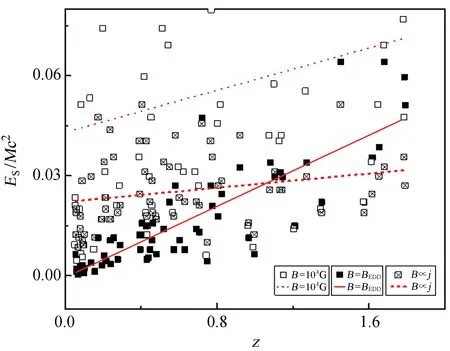Blazar黑洞自旋能量与红移相关性研究*
2015-03-24张旭,张雄
张 旭,张 雄
(云南师范大学物理与电子信息学院,云南 昆明 650500)
CN 53-1189/P ISSN 1672-7673
Blazar黑洞自旋能量与红移相关性研究*
张 旭,张 雄
(云南师范大学物理与电子信息学院,云南 昆明 650500)
黑洞自旋及其参量能提供黑洞合并及吸积的信息。从文献资料中收集了112个Blazar源,这些源包含了67个FR II射电星系(RG),11个FR II射电噪类星体(RLQ),27个核占优星系(CD)。通过样本数据研究黑洞自旋能量与红移的相关性。研究结果表明:(1)112个Blazar的黑洞自旋能量与红移存在相关性,尤其在爱丁顿磁场条件下(B=BEDD),黑洞自旋能量与红移的相关性最为明显;(2)FR II射电星系(RG)、FR II射电噪类星体(RLQ)、核占优星系(CD)的黑洞自旋能量在3种磁场条件下(B=BEDD,B=104G,B∝j)与红移的相关性强弱上存在差异,但总体趋势较为相似,均呈现正比关系;(3)黑洞自旋能量与红移的强相关性表明,黑洞自旋能量在一定程度上给出黑洞并合与吸积的信息。这些研究结果与其他人用其他方法获得的结果是一致的。
Blazar;黑洞自旋;自旋能量;红移;相关性
黑洞自旋和质量是Blazar的两个基本物理量。黑洞自旋与黑洞合并和吸积有着明显的关系[1]。文[2-7]的研究均得出相同的结论。文[2]认为黑洞自旋和质量的变化在二元合并时是同时发生的。在并合的过程中黑洞的自旋速率会慢慢降低。文[6]认为大质量黑洞的吸积可能是由一系列连续随机的吸积事件组成的,正是由于这些吸积事件使大质量黑洞具有中等的自旋。文[8]认为自旋及其参量与红移一样的功能,能对AGN黑洞的并合与吸积特征进行精确的描绘。
大质量黑洞自旋的研究为大质量黑洞合并与吸积提供了全新的视角。现在有很多可行的方法估算大质量黑洞的自旋。例如当AGN吸积盘区域能观测到X射线时,就可根据其辐射光谱的特性估算黑洞自旋[9]。又如当一个AGN拥有较强的喷流时,其喷流的特性也可用于估算AGN黑洞的自旋大小。正如文[10]所总结的,当黑洞样本中有X射线辐射源或较强的喷流时能提供一个凭借经验估算黑洞自旋的途径。
在文[11-12]的模型中黑洞自旋能量与自旋在不同磁场下均存在紧密的联系。研究显示,黑洞自旋能量作为黑洞自旋的重要参量,与红移之间同样存在着相关性。文[5]认为,对自旋及其自旋能量的研究同红移一样,可以对AGN黑洞的合并吸积特性进行精确的描绘。但目前为止自旋及自旋能量与红移关系仍没有统一定论。
文[1]讨论了自旋与红移的关系,其结果表明自旋与红移存在着明显的相关性。但对于黑洞自旋能量仅仅讨论了黑洞吸积盘提取的自旋能量片段,没有详细讨论黑洞自旋与黑洞质量共同作用下的总自旋能量与红移的相关性。本文对黑洞的自旋能量与红移进行相关性分析。
运用文[1, 13]的黑洞样本数据为基础将数据扩大到112个Blazer源,其中包含了67个FR II射电星系(RG)、11个FR II射电噪类星体(RLQ)、27个中核星系(CD)。运用黑洞自旋的关系式计算出自旋能量,讨论了不同类型的源在3种不同特性磁场下黑洞自旋能量与红移的相关特性,得出的结果表明Blazer黑洞自旋能量与红移存在较为直接的联系,这与文[1]得出的结论相同。同时也表明黑洞自旋能量同样能在一定程度上给出黑洞合并与吸积的信息。本文给出了用模型公式估算Blazer自旋能量大小的方法,为下一步自旋能量与模型的研究提供了依据。
1 黑洞自旋及自旋能量的计算
1.1 黑洞自旋
计算黑洞自旋数据的方法与文[13]相同。在著名的BZ模型中电子束功率Lj的产生与自旋j的关系:
(1)
rH为黑洞视界半径(rH=2GM/c2);Bp0为黑洞视界磁场强度;j≡Sc/(GM2);M8为108M⊙为单位的黑洞质量;B4为104G为单位的电磁场轴相分量强度。
(2)

(3)
当黑洞喷流较强时用这种方法估算黑洞自旋比较准确[13]。这种方法是基于喷流较强时其自旋能量与旋转的黑洞周围区域的吸积物质有关的标准模型[14-16]。很多黑洞自旋与喷流电子束关系模型中*http://arxiv.org/abs/1307.3246,磁场强度和黑洞质量通常被设定为常数[17-18],它们有如下关系[19-20]:
(4)
Lj为黑洞喷流电束功率;M是黑洞质量;j为黑洞自旋量,j=a/m,a=S/(Mc),m=GM/c2;S为黑洞自旋的角动量大小;c为光速;B为吸积盘和黑洞的电磁场轴相分量的强度[21]。由此算出黑洞自旋量j的值*http://arxiv.org/abs/1312.6698:
(5)

1.2 自旋能量
在本文中运用文[1]的计算公式求出黑洞样本的自旋能量。用(5)计算出黑洞自旋j后,可以用其估算自旋能量ES[23]:
(6)

2 实验结果
根据文[1]及文[15]的黑洞样本[1,15]收集扩充了Blazar源[14],用(5)、 (6)式计算了相关的量给出了表1。本文着重讨论黑洞自旋能量与红移的相关性。计算过程这里不再复述。数据源按红移值由小到大排列。
在考虑黑洞质量的情况下,由图1、2、3可以看出ES/Mc2与红移z分别在B=BEDD、B=104G、B∝j3种磁场情况下具有较高的相关性。说明黑洞的自旋能量和红移z都存在联系,红移z与黑洞自旋能量在总体上的关联紧密。自旋能量与红移的关系满足Blazar的一些基本观测特征。


图1 ES/Mc2与红移z的相关性(B=BEDD)
Fig.1 The correlation between redshifts andES/Mc2(withB=BEDDassumed) of the black holes
图2ES/Mc2与红移z的相关性(B=104G)
Fig.2 The correlation between redshifts andES/Mc2(withB=104G assumed) of the black holes
如图4射电星系ES/Mc2与红移z在3种不同磁场下均存在一定相关性。在爱丁顿磁场(B=BEDD)条件下射电星系的ES/Mc2与红移z存在强相关性。但在B=104G与B∝j两种磁场条件下,射电星系ES/Mc2与红移z有弱相关性。但总体上射电星系ES/Mc2与红移z存在正比关系,说明黑洞的自旋能量随红移z的增大而增加。这与文[1]的研究结果相同。
如图5射电噪类星体(RLQ)的ES/Mc2与红移z的相关性与射电星系(RG)相比较低,但数据整体趋势非常相似。射电噪类星体(RLQ)ES/Mc2与红移z在3种不同磁场下均存在一定相关性。在B=BEDD磁场条件下,射电噪类星体(RLQ)Es/Mc2与红移z存在强相关性。但在B=104G与B∝j两种磁场条件下,射电噪类星体ES/Mc2与红移z有弱相关性。但总体上射电星系(RG)的ES/Mc2与红移z存在正比关系,说明黑洞的自旋能量随红移z的增大而增加。这与文[1]的研究结果也是相同的。

表1 黑洞红移质量自旋及自旋能量
续 表

Source(1)Type(2)z(3)L44a(4)M8b(5)JM(B=BEDD)(6)Es(B=BEDD)Mc2(7)JM(B=104)(8)Es(B=104)Mc2(9)JM(B∝j)(10)Es(B∝j)Mc2(11)3C340RG0775465110400210940720079681051003559 3C352RG080683160370017902057004563 045002711 3C2631RG082413019043002459506005131704600284243C1751RG092110120490032601085012627705500420953C356RG107925028050034074055004209504400258343C252RG1105170200470029777063005750504800311693C368RG113224028048003116905400404 04400258343C267RG1144190240470029777055004209504400258343C324RG121150370340015006033001410403400150063C266RG127222023050034074062005538304700297773C13RG1351260400410022226039001999603800189334C1366RG14526016066006424709902446630600513173C682RG1575210350410022226041002222603800189333C241RG161737037051003559 05003407404300245953C470RG165329028053003875106005131704700297773C322RG1681510320660064247068006908304900326013C294RG17864402906400596880710076907051003559 3C239RG179480370600513170580047473045002711 3C334RLQ055562500190004564015000283302300067253C254RLQ07346320030011582039001999603700179023C1751RLQ076813079021000559 014000246502200061443C336RLQ092710016041004563 063021161404700493683C245RLQ1029160250410022226049005750504200297773C212RLQ1049190160560022226084003260105500233933C186RLQ106321032041004383804401217670400420953C208RLQ1109230250490022226059002583404600210943C204RLQ111217032038003260104004936803800284244C1649RLQ129622063030018933023002109402900189333C681RLQ1238410790380018933025000797 0300115823C181RLQ138233040047001158204400067250400108023C2684RLQ1483063060051317045002711 0400210943C191RLQ1952360050056002978 048002711 04100210943C9RLQ201294063063004383804700312 0410022226M87CD00042006860014000001 002800001 010001254CentaurusCD00110074860015000003 003100001 010001254HCG62CD00140039570014000003 0034000012 0110001254A262CD00160097860018000002 003500001450110001518PerseusCD001815170049000004 00700001530160001518PKS1404-267CD00220257003100003 007600006130160003226A2199CD00327200061000012 00800007230170003226A2052CD0035151700490000466007000080201600036462A0335+096CD003502414002200003 003300006130110003226MKW3SCD00454186012000005 02300001360290001518A4059CD00480962900310001808003300067250110010802HydraACD0055431101000012 01800001360250001518
续 表

Source(1)Type(2)z(3)L44a(4)M8b(5)JM(B=BEDD)(6)Es(B=BEDD)Mc2(7)JM(B=104)(8)Es(B=104)Mc2(9)JM(B∝j)(10)Es(B∝j)Mc2(11)A85CD00550372900190001254002100040920086000797 CygnusACD005613290110000005012000006 0210000927Sersic159/03CD005878170110001518016000180804000559 A133CD00662200093000151801200032260210021094A1795CD006316230044000108400540001808014000559 A2029CD00770876000200002420015000036500730002465A478CD00811260033000005 003800000030120000667A2597CD008506786004700001360093000018101800018083C388CD009221700570000276008100010840170004092PKS0745-191CD01031731012000040701300008220210003646HerculesACD015431200066000180800860002124017000559 Zw2701CD0214601703100005450440000927040003646MS07356+7421CD021669200310012393041002583403800210944C5516CD02424214009001239301400222260220018933A1835CD02531854010001015007600024650160006144Zw3146CD0291587401500012540100007230190003226
注:表中 (1) 源; (2) 类型; (3) 红移; (4) 喷流中电子束功率; (5) 黑洞质量部分来源于文[13]及文[14],其余均源于NED 网络数据库; (6) 爱丁顿磁场条件下的自旋; (7) 爱丁顿磁场条件下的自旋能量; (8) 静磁场条件下的自旋; (9) 静磁场条件下的自旋能量; (10) 与自旋有关的磁场条件下的自旋; (11) 与自旋有关的磁场条件下的自旋能量 (运用(6)式计算得出)
Notes: The meanings of the columns are as follows. Column (1): Source name. Column (2): AGN type. Column (3): Redshift value. Column (4): Power of the electron beam in the jet. Column (5): Mass value of the black hole. Column (6): Spin of the black hole withB=BEDDassumed. Column (7): Spin energy of the black hole withB=BEDDassumed. Column (8): Spin of the black hole withB=104G assumed. Column (9): Spin energy of the black hole withB=104G assumed. Column (10): Spin of the black hole withB∝jMassumed. Column (11): Spin energy of the black hole withB∝jMassumed.


图3 ES/Mc2与红移z的相关性(B∝j)
Fig.3 The correlation between redshifts andES/Mc2(withB∝jMassumed) of the black holes
图4 RG类黑洞ES/Mc2与红移z的相关性
Fig.4 The correlation between redshifts andES/Mc2of the black holes in RG-type AGN
如图6,核占优星系(CD)的ES/Mc2与红移z在3种不同磁场的相关性均存在相关性。在B=BEDD,B=104G,B∝j3种磁场条件下,核占优星系(CD)的ES/Mc2与红移z均存在较明显的相关性。说明核占优星系(CD)的黑洞自旋能量在3种磁场条件下均与红移z存在较为直接的关联。


图5 RLQ类黑洞ES/Mc2与红移z的相关性
Fig.5 The correlation between redshifts andES/Mc2of the black holes in RLQ-type AGN
图6 cD类黑洞ES/Mc2与红移z的相关性
Fig.6 The correlation between redshifts andES/Mc2of the black holes in cD-type AGN
不同条件下黑洞自旋能量与红移的相关性的详细分析数据如表2。总体上ES/Mc2均与红移z存在相关性。自旋能量随红移z的增大而增加,与文[1]的研究结论相同。
表2 不同条件下黑洞自旋能量与红移的相关性数据
Table 2 Results of the correlations between spin energies and redshifts of the black holes in different types of AGN under different assumptions ofB

XYNRValueProb>FValue(Intercept)Value(Slope)Error(Slope) B类型ZES/Mc211208020-00014 0023 00017B=BEDD—ZES/Mc211208270000020025 00028B=104G—ZES/Mc211208270000420013 00018B∝j—ZES/Mc267084 000022-0027 -00003 B=BEDDRGZES/Mc26701420259004290016 00139B=104GRGZES/Mc26702430051002210005 00027B∝jRGZES/Mc21107120003-00048 0023 00064B=BEDDRLQZES/Mc2110293029 001070012 00112B=104GRLQZES/Mc211039601440010200073200047B∝jRLQZES/Mc227060100020000100040700012B=BEDDCDZES/Mc227052900090000300048700017B=104GCDZES/Mc22704920017000210010540004 B∝jCD
注:表中类型“—”表示本文中RG, RLQ, cD 3种类型均考虑的总体情况
Notes: The sign‘—’means the results are for all AGN types (RG, RLQ, and cD) combined
3 结 论
由于射电噪类星体(RLQ)及核占优星系(CD)的样本数量较少,可能对黑洞自旋能量与红移的相关性分析产生一定的误差。要进一步详细探讨黑洞自旋能量与红移的相关性以及测定自旋能量与红移的关系公式,就需要更多的观测数据来验证本文的研究结果。
本文依据文[14]与文[1]的黑洞质量、中子束功率及磁场强度等运用(1)式(Blandford & Znajek[13]Blandford[28];Meier[12];Narayan[21])依次计算出3种磁场条件下的自旋j,后运用(3)式计算出对应的ES/Mc2(其中自旋、黑洞、磁场测量值均独立于红移),并依据文[2]和文[6]的模型,对黑洞自旋能量进行估算。最后对黑洞自旋能量与红移进行相关性分析。
本文结果表明Blazar的黑洞总体自旋能量与红移存在关系,尤其以在爱丁顿磁场条件下(B=BEDD)最为明显。黑洞自旋能量在3种不同类型的磁场条件下(B=BEDD,B=104G,B∝j)的趋势均较为相似,呈现正比关系。实验结果与文[1]得出的结论相同。说明Blazar黑洞自旋能量与红移存在较直接的联系。这为依据红移与自旋能量的关系,估算Blazar自旋能量提供了依据。黑洞自旋和质量的变化在二元合并时是共同发生的,随着合并的发生其自旋速度降低。由于黑洞自旋能量与AGN红移的相关性,可推断黑洞自旋能量能如同红移一样可以对AGN黑洞的合并吸积历史进行一定的描绘。
[1] Daly R A, Sprinkle T B. Black hole spin properties of 130 AGN[J]. Monthly Notices of the Royal Astronomical Society, 2014, 438(4): 3233-3242.
[2] Hughes S A, Blandford R D. Black hole mass and spin coevolution by mergers[J]. The Astrophysical Journal Letters, 2003, 585(2): L101-L104.
[3] Volonteri M, Rees M A. Rapid growth of high redshift black holes[J]. The Astrophysical Journal, 2005, 633(2): 624-629.
[4] King A R, Pringle J E. Fuelling active galactic nuclei[J]. Monthly Notices of the Royal Astronomical Society, 2007, 385(3): 1621-1627.
[5] Volonteri M, Sikora M, Lasota J P. Black-hole spin and galactic morphology[J]. The Astrophysical Journal, 2007, 667(2): 704-713.
[6] Berti E, Volonteri M. Cosmological black hole spin evolution by mergers and accretion[J]. The Astrophysical Journal, 2008, 684(2): 822-828.
[7] Zhang S N, Cui W, Chen W. Black hole spin in X-ray binaries: observational consequences[J]. The Astrophysical Journal, 1997, 482(2): L155-L158.
[8] McClintock J E, Narayan R, Steiner J F. Black hole spin via continuum fitting and the role of spin in powering transient jets[J]. Space Science Reviews, 2013, 2(1): 256-258.
[9] Steiner J F, McClintock J E. Measuring black-hole spin and modeling the jet dynamics in microquasar XTE J1550-564[J]. Monthly Notices of the Royal Astronomical Society, 2011, 416(1): 941-946.
[10]Richardson G A, Nishikawa K I. Simulations of relativistic jet formation[J]. The Astrophysical Journal, 1999, 35: 1333.
[11]Blandford R D. Spectrum of a radio pulse from an exploding black hole[J]. Monthly Notices of the Royal Astronomical Society, 1977, 181(2): 489-498.
[12]Schmoll S, Miller J M, Volonteri M, et al. Constraining the spin of the black hole in Fairall 9 with Suzaku[J]. The Astrophysical Journal, 2009, 703(2): 2171-2176.
[13] Daly R A. Estimates of black hole spin properties of 55 sources[J]. Monthly Notices of the Royal Astronomical Society, 2011, 414(2): 1253-1262.
[14]Reynolds C S, Garofalo D, Begelman M C. Trapping of magnetic flux by the plunge region of a black hole accretion disk[J]. The Astrophysical Journal, 2006, 651(2): 1023-1030.
[15]Tatum M M, Turner T J, Miller L, et al. The global implications of the hard X-ray excess in type 1 AGN[J]. The Astrophysical Journal, 2012, 762(2): 80-108.
[16]Tchekhovskoy A, Narayan R, McKinney J C. Efficient generation of jets from magnetically arrested accretion on a rapidly spinning black hole[J]. Monthly Notices of the Royal Astronomical Society, 2011, 418(1): L79-L83.
[17]Thorne K S, Price R H, MacDonald D A. Book-review-black-holes-the membrane paradigm[J]. The Astrophysical Journal, 1990, 311(2): 122.
[18] Nardini E, Fabian A C, Walton D J. Investigating the reflection contribution to the X-ray emission of Ton S180[J]. Monthly Notices of the Royal Astronomical Society, 2012, 423(4): 3299-3307.
[19] Zoghbi A, Fabian A C, Uttley P, et al. Broad iron L-line and X-ray reverberation in 1H0707-495[J]. Monthly Notices of the Royal Astronomical Society, 2010, 401(1): 2419-2432.
[20]Daly R A. Bounds on black hole spins[J]. The Astrophysical Journal Letters, 2009, 696(1): L32-L33.
[21]Narayan R, McClintock J E. Observational evidence for a correlation between jet power and black hole spin[J]. Monthly Notices of the Royal Astronomical Society, 2011, 419(1): L69-L73.
[22]Blandford R D, Netzer H, Woltjer L. Active galactic nuclei [M]. New York: Springer-Verlag, 1990.
[23]Punsly B, Coroniti F V. Relativistic winds from pulsar and black hole magnetospheres[J]. The Astrophysical Journal, 1990, 350(2): 518-535.
[24]Rees M J. Black hole models for active galactic nuclei[J]. Annual Review of Astronomy and Astrophysics, 1984, 22(1): 471-506.
[25]King A R. Black hole outflows[J]. Monthly Notices of the Royal Astronomical Society, 2010, 402(1): 1516-1522.
[26]Daly R A, Mory M P, Guerra E J. High-redshift radio galaxies as a cosmological tool: exploration of a key assumption and comparison with supernova results[C]// American Institute of Physics Conference Proceedings. 2002: 87-94.
[27]Allen S W, Dunn R J H, Fabian A C, et al. The relation between accretion rate and jet power in X-ray luminous elliptical galaxies[J]. Monthly Notices of the Royal Astronomical Society, 2006, 372(1): 21-30.
[28]Merloni A, Heinz S. Measuring the kinetic power of active galactic nuclei in the radio mode[J]. Monthly Notices of the Royal Astronomical Society, 2007, 381(2): 589-601.
A Study of Correlations between Redshifts and SpinEnergies of Black Holes in AGN
Zhang Xu, Zhang Xiong
(College of Physics and Electronic Information Technology, Yunnan Normal University, Kunming 650500,China, Email: kmzhanghj@163.com)
We have collected a sample of 112 Blazars. Our sample includes 67 FRII Quasars, 11 FRII Radio-Loud Quasars, and 27 FRII cD galaxies. The Quasars and Radio-Loud Quasars have redshifts from about 0 to about 2. We have analyzed correlations between redshifts and spin energies of black holes for our sampled AGN. The spin energies were calculated using a set of assumptions. Our conclusions are as follows. (1) The spin energies of the sampled Blazars show appreciable correlations with redshifts; the correlations are most obvious if magnetic-field strengths (B)around the black holes are assumed to followB=BEDD; (2) The correlations are similar for different types of Blazars and for three different assumptions of magnetic-field strengths (, i.e.,B=BEDD,B=104G, andB∝jM); (3) The results suggest that spin energies statistically increase with redshifts for black holes in the redshift range of 0 to 3, which is consistent with independent studies of other authors.Key words: Blazar; Spin of a black hole; Spin energy; Redshfit; Correlation
国家自然科学基金 (U1231203);国家自然科学基金 (11163007);云南省自然科学基金项目 (2010CD046);云南省高能天体物理重点实验室资助.
2014-10-12;修定日期:2014-11-01
张 旭,男,硕士. 研究方向:黑洞,活动星系核. Email: 2226997466@qq.com
张 雄,男,教授. 研究方向:黑洞,活动星系核. Email: kmzhanghj@163.com
P157.2
A
1672-7673(2015)03-0253-09
